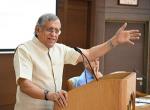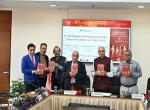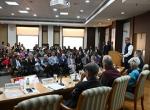On 21 April 2023, the Vivekananda International Foundation (VIF) organised a talk on “India-Bhutan Bilateral Relationship”. Lt General R K Sawhney gave the introductory remarks, followed by presentations by the expert group on the issues of the internal political situation, trade and hydropower cooperation and security and borders. Lt Gen Sawhney welcomed the speakers and the participants and shared some key insights on the strategic significance of Bhutan in our neighbourhood.
Bhutan is a constitutional monarchy since 18 July 2008, bordering two Asian giants, India and China. Bhutan has a population of 7.77 lakhs. The next National Assembly elections are scheduled for October 2023. Elections are generally quiet, peaceful and the least disruptive affair in Bhutan. The King of Bhutan is a highly respected individual responsible for the security of Bhutan. The Prime Minister keeps the King informed at all times about foreign policy and other policy issues, and the King has a say in the matters of the State.
Bhutan is a USD 2.7 billion economy with a growth rate of 4.7 per cent in the year 2022. India is the biggest export destination of Bhutan, accounting for 93 per cent of its total exports. In 2022-23, India’s growth rate of exports with Bhutan was at 21 per cent. However, the imports were at -3 per cent, showcasing a wide trade deficit with the balance of trade standing at USD 538.28 million.
Even though the HEP partnership between the two countries started off with excellent cooperation, it eventually stagnated. India’s commitment to Bhutan was 10,000 MW capacity building by 2020. However, it could deliver only 2136 MW by 2023. A capacity to generate an additional 2,220 MW with Punatsangchhu I and II projects in west Bhutan is still under construction. After noticing a lack of interest on India’s part, Bhutan also had to abandon the Sankosh HEP, which was supposed to generate about 2585 MW. There has been very little development in the progress of the HEPs between the countries.
Bhutan shares a 477 km-long border with China. Bhutan and China have border disputes in the north as well as in the west of Bhutan. The border negotiations between the two countries started in 1984. Since then, 11 expert group meetings and 24 rounds of border negotiations have been held. The 11th Expert Group Meeting (EGM) on the China-Bhutan Boundary Issues was held in China’s Kunming City in January 2023.
The bone of contention at the China-India-Bhutan tri-junction is in the Chumbi valley. Both India and Bhutan put the tri-junction near Batang La. The Chinese, however, insist that the tri-junction is at Mount Gipmochi. In June 2017, Indian and Chinese troops were arrayed face-to-face on the Doklam plateau, close to the Indian Army post of Doka La, located between Batang La to the north and Gymochen to the south. India has developed and improved connectivity and defence capabilities in these areas over the years. Similarly, China has also developed substantial infrastructure and model villages in the Chumbi Valley in the Tibet Autonomous Region (TAR).







Post new comment